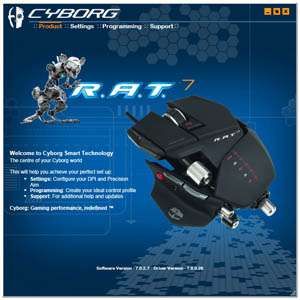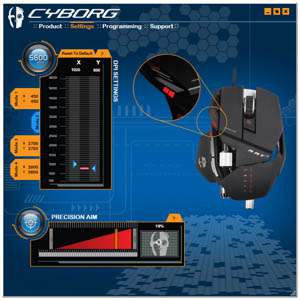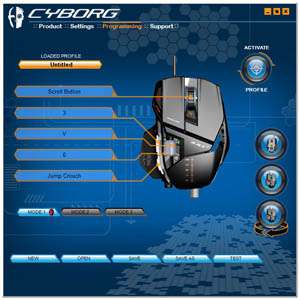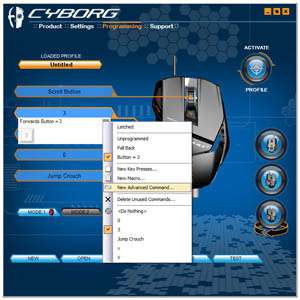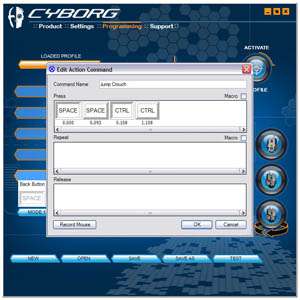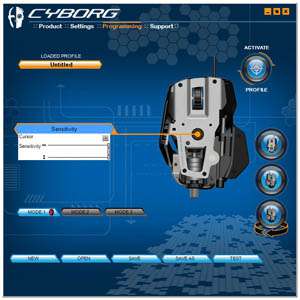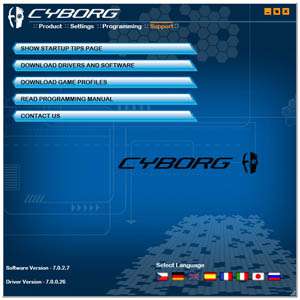- Qualcomm Launches Snapdragon 4 Gen 2 Mobile Platform
- AMD Launches Ryzen PRO 7000 Series Mobile & Desktop Platform
- Intel Launches Sleek Single-Slot Arc Pro A60 Workstation Graphics Card
- NVIDIA Announces Latest Ada Lovelace Additions: GeForce RTX 4060 Ti & RTX 4060
- Maxon Redshift With AMD Radeon GPU Rendering Support Now Available
Mad Catz Cyborg R.A.T. 7 Gaming Mouse
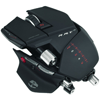
For the gamer looking to find a great mouse, the choices are limitless. But how often does one “feel” perfect? To cater to gamers who don’t mind taking time to customize a mouse to a huge degree, Mad Catz delivers its R.A.T. series. With full ability to customize both the body and software, R.A.T. could be perfect for everyone.
Page 4 – Software
The software installation process can have a somewhat mixed result, depending on the OS you choose to use. Folks on Windows 7 will have no problems at all, since as soon as you plug the mouse in, Windows will just do it’s thing and download the drivers for you, or at least give you the chance via Windows Update.
Those still using the now somewhat antiquated Windows XP, the installation is a bit of a chore. Plug in the mouse and the standard HID compliant driver kicks in and you can use the mouse fine, just none of the extra buttons work. Popping the CD in and running the installer; you’ll be greeted with multiple pop-ups. It tells you to let windows automatically find the driver on the CD – 3 times. Not the most elegant installation. This isn’t too much of a problem these days as XP’s market share dwindles by the day.
After the install, a new icon will be present in the taskbar, ready for you to start editing and programming away. When the splash screen passes and you’re greeted with the product overview page, a tip box will open as well – which can be disabled.
The first tab you can hit on is ‘Settings’, which controls the DPI levels and Sniper button. These settings are fixed and are completely independent from profiles. As a result, you can not set different DPI levels for different modes. There is independent control over each axis but there is a button missing for mouse acceleration, which if you need to turn off, you’ll have to go to the OS-based menu instead.
Up to 4 DPI levels can be set, but the precision aim is limited to a single setting for all modes. Having the ability to set different precision aim values for each DPI level would be useful, maybe something for a future version.
Moving on to the ‘Programming’ tab and we’re greeted with a rather fancy overview of the mouse and the available buttons that can be changed. There are 3 modes available for each profile you create. These can be changed via the mode button on the mouse next to the left mouse button. Each mode is given a color of Red, Blue and Purple.
One thing that’ll probably catch many off guard; as you’d have to read the manual thoroughly to find out, is that Mode 1, Red, acts as the default profile and will overwrite all other modes when changed. This can be infuriating at first as it means changing the other mode settings again if you make a mistake. So the best thing to do is leave mode 1 alone and edit 2 and 3 only.
It’s worth mentioning now that the mouse has no memory at all and is completely software-dependent for it’s extra functionality. This is rather unfortunate, as this can lead to aggravation should you either use the mouse on another computer or merely unplug and replug the mouse back in.
Hovering the cursor over any of the button labels will produce a drop-down menu showing you the current button or macro settings. Clicking in the blank space will start the key press recorder – very simple. Clicking on the little black arrow in the corner will expand the full list of options available.
The commands available are not exactly clear as to their function by name alone. ‘Latched’ is a tag meaning ‘repeat until the button is pressed again’, so it’ll keep looping through the macro or key presses until you press the button again to tell it to stop. ‘Unprogrammed’ resets the button back to default. ‘Fall Back’ is complicated, as it assigns the same key across all three profile modes.
‘New Key Presses’ and ‘New Macro’ seem to do the same thing, enable macro recording like you would if you were to just click on the blanks pace when the button setting drops down. The manual says otherwise, the difference is that a ‘Key Press’ button must be held down till it finishes, but under testing, it seems to perform the entire action regardless. Macros are meant to be a click-and-forget event and do not require the button to be held down. Again, under testing, both seemed to do the same.
‘New Advanced Command’ opens the ‘Edit Action Command’ menu, allowing you to record more complicated commands and timed events. Mouse actions can be recorded as well (but not movement). The first bar ‘Press’, will activate the keys entered when the button is pushed down. The ‘Repeat’ bar will continue to repeat the actions listed while the button is held down. ‘Release’ – if you haven’t guessed already, will perform the final actions detailed as a macro when the button is released. The major difference is that all actions are timed, unlike normal macros. So key down, time started, held and released, are all recorded.
Any changes made to button events must be activated first before they can be used; the same for any changes made after. The single button on the top-right corner, labeled ‘ACTIVATE’ needs to be pressed each time you make a change. The 3 large icons grouped together change the display of the mouse. The middle is the default and shows the button editing options described above. The third of the bottom options is a 360 degree spin (for whatever reason). The top option shows you the reverse and allows you to control the sensitivity of the mouse, much like the OS-based option.
Unused commands can be deleted as every action you program in, gets added to the context menu for quick selection. Just click the black arrow on any button and select the option to perform.
When you have things setup the way you want, you can press ‘Save As’, give it a name and done. A word of warning, if you try to overwrite an existing save using save as, even if you confirm, it will still act like nothing has happened, so click save instead if you’re making any changes. Remember to activate after.
The last tab is ‘Support’. Little effort went into this, which is a bit of a shock. Hover over each link and you’ll be greeted with a short description… and typo "…from the our website." Not a big deal, but oh well. The real problem is with the drivers and software option. This links to the Saitek website which doesn’t actually have the drivers for the Cyborg R.A.T. series of mice. You have to click on the ‘Read Programming Manual’ link under support, then ‘Download Drivers’ on the web page to get the correct updates from the CyborgGaming website. At time of writing however, the drivers and software on the CD are later versions than those made available online.
Support our efforts! With ad revenue at an all-time low for written websites, we're relying more than ever on reader support to help us continue putting so much effort into this type of content. You can support us by becoming a Patron, or by using our Amazon shopping affiliate links listed through our articles. Thanks for your support!




